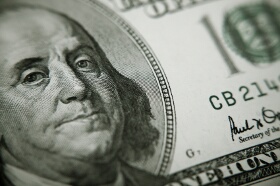The US dollar declined against the euro on Friday, following a report that showed that the rate of economic growth in the United States failed to impress investors. The greenback fell harder against its Canadian counterpart as gross domestic product of the United Statesâ northern neighbor grew faster than expected.
In its first estimate for gross domestic product in the second quarter of 2017, The US Bureau of Economic Analysis stated that the US economy grew at a rate of 2.6%. The growth rate came close to analyst expectations of 2.7%, which let down investors who hoped for a better growth in the second quarter.
The final reading for gross domestic product in the first quarter was 1.2%. The bureau releases three estimates for each quarter, with a one month gap between each release and the next.
The stronger growth in the second quarter was partly attributed to higher consumer spending, stronger exports, and improved federal government spending. Meanwhile, lower residential and inventory investments, higher imports, and weaker local government spending worked against further acceleration in the US gross domestic product.
A separate report failed to support the greenback today after revealing a marginally stronger consumer confidence than expected. The University of Michigan said that its consumer sentiment index had a reading of 93.4 in July, which compared to estimates of 93.1.
On the other hand, the Canadian dollar surged against the US peer as Canadaâs economy grew faster than forecasts in May. Statistics Canada stated in a fresh report today that gross domestic product rose 0.6% in May, exceeding estimates of a 0.2% increase.
EUR/USD rose to 1.1747 as of 16:30 GMT on Friday from 1.1687 when trading began today. EUR/USD touched 1.1760 at 15:40 GMT, the highest level since yesterday. USD/CAD fell to 1.2434 after starting the day at 1.2539. USD/CADâs lowest point today was 1.2420.
If you have any questions, comments or opinions regarding the US Dollar,
feel free to post them using the commentary form below.
